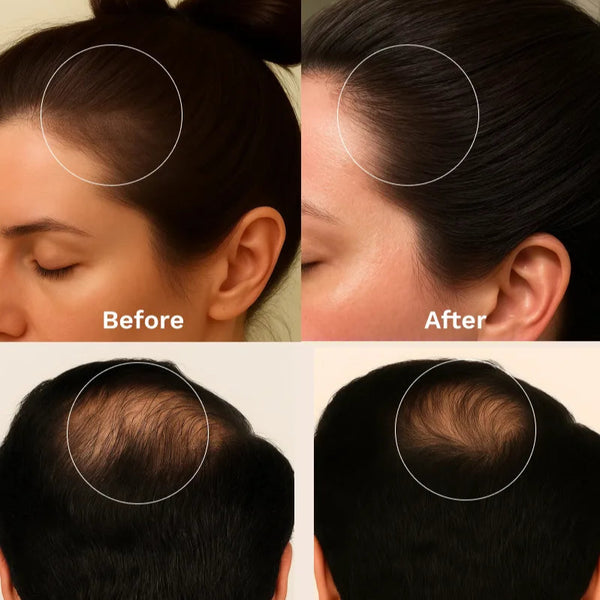In this article
Noticing your once-thick hair looking finer, or catching more scalp than strands when you glance in the mirror? If so, genetics may be stepping in as the unwelcome stylist.
Male pattern baldness is one of the most common hereditary changes men face, but the good news is you can spot the signs early and explore solutions before it progresses too far. Think of this as your guide to understanding how your DNA shapes your hairline and what steps you can take to push back.
The hallmark signs of genetic hair loss include a receding hairline around the temples and gradual thinning on the crown. If baldness runs in your family—whether it’s your dad, uncles, or grandparents—you’re more likely to see the same pattern.
That said, genetics isn’t the only culprit. Stress, illness, and other factors can play a role too. That’s why checking in with a healthcare professional is key if you want a clear diagnosis and the right treatment plan for your situation.
Key Takeaways
-
Baldness is mostly genetic, with family history on both sides playing a role.
-
Male pattern baldness is polygenic, not caused by a single gene, and can vary even within the same family.
-
Myths like inheriting baldness only from the mother’s side are incomplete since many genes are involved.
-
Early signs include temple recession and crown thinning, but lifestyle factors like smoking and poor scalp care can also worsen hair loss.
Does Genetics Cause Baldness?
When genes drive hair loss, it follows familiar patterns in men (MPB) and women (FPB). In men, MPB often starts with an M-shaped recession in the 20s or 30s.
By mid-life, about half of men are affected. For women, thinning often appears after menopause as widening of the part. Genetics play a strong role; a twin study estimated heritability at ~0.81.
In short, androgenetic alopecia is common and strongly genetic, which is why family history is such a useful clue.
Genetics and Baldness Inheritance
Baldness risk does not come from one “baldness gene” or a simple recessive pattern. It is polygenic, with risk coming from many genes on both autosomes and the X chromosome.

Large genetic studies have identified dozens to hundreds of risk loci, including a well-known signal near the androgen receptor (AR) on the X chromosome.
More recent reviews count hundreds of independent loci tied to male-pattern hair loss. This is why family history on both sides can matter.
Is Your Mother Really the Sole Cause of Your Baldness?
A common myth about male pattern baldness is that you inherit it only from your mother’s side. While that’s partly true, it doesn’t tell the full story. The X chromosome, which men inherit from their mothers, does carry a key baldness gene. That’s why many people say your mother’s side has the strongest influence.
But baldness is polygenic, meaning multiple genes play a role, not just one. You inherit genetic input from both sides of the family. Men receive their X chromosome from their mothers and their Y chromosome from their fathers. The AR gene on the X chromosome has a strong link to baldness, but it’s far from the only factor.
Learn the causes of female pattern hair loss
In fact, one review identified 63 genes tied to male pattern baldness, and only six of them sit on the X chromosome. That’s why you’ll often notice baldness running through your father’s side as well. Many men who lose hair also have a bald father.
Genetics can also surprise you. Sometimes baldness skips a generation, or even shows up differently among siblings. You might thin early while your brother keeps a full head of hair. If baldness is common on both sides of your family, though, your odds are higher.
And while the X chromosome carries one of the most important genes, research suggests other genes—independent of whether they come from your mother or father—also contribute to hair loss.
Who Do You Really Inherit Your Hair From?
Dermatologists often remind patients that your hair’s thickness, texture, and even color come from the genes you inherit from both parents. You carry two copies of each gene—one from your mother and one from your father—and together they shape how your hair looks and behaves.
Hair genetics, though, aren’t simple. Hair loss and hereditary influence work in complex ways, so there’s no single “yes or no” answer when it comes to predicting your future hair. That said, your family history gives you one of the clearest clues.
If thinning or baldness runs on either side, chances are you may notice similar patterns over time. I’ve seen plenty of people compare their hairline with a parent’s or grandparent’s and realize just how much genetics can echo through generations.
Will You Go Bald If Your Dad Is Bald?
One of the easiest ways to guess where your hair might be headed is by looking around your own family. Take a look at the men closest to you—your father, uncles, maybe even brothers. If your dad is bald, your odds of developing male pattern baldness are higher than someone without that family history.
That said, your father’s hairline isn’t the final word on your future. Baldness comes from a mix of genetic and environmental influences, so it’s not as simple as inheriting one trait.
Learn the signs of male pattern baldness
I’ve seen families where one brother loses hair early while another keeps a full head well into his 50s. Having a bald father does raise your chances, but it doesn’t guarantee the same outcome for you.
Does Baldness Really Come From Your Maternal Grandfather?
Your maternal grandfather’s hair can tell you a lot about your own future hairline. Just like with your dad, his hair pattern often hints at what you might expect down the road. The reason comes back to how sensitive you are to DHT, a byproduct of testosterone.
Here’s the tricky part: DHT binds to receptors in your hair follicles, which slowly shrinks them. At first, the follicles produce thinner, shorter hairs, but over time they can get so small they stop producing visible hair altogether. That’s when thinning turns into bald spots.
Because this sensitivity is thought to pass down on your mother’s side, your maternal grandfather becomes a strong clue about how your own follicles may react to testosterone and DHT. If he held onto thick hair, you might too. If he didn’t, you could share that same tendency.
Can Baldness Really Skip a Generation?
One of the questions our South Florida dermatology team hears most often is whether baldness skips a generation. The truth is, the inheritance pattern of male-pattern baldness is complicated and still not completely understood. What we do know is that multiple genes play a role.
Sometimes baldness seems to skip a generation, but that isn’t a consistent or reliable rule. You might see your grandfather bald while your father keeps a full head of hair, only to notice thinning yourself years later. That unpredictability makes it tough to draw clear conclusions just from family history.
If you’re worried about your own risk, the best step is to talk with a healthcare provider or genetic counselor. They can look at your background and give you more specific guidance instead of relying on guesswork.
How Genetic Baldness Works Across Generations
When you want to gauge your risk of genetic baldness, a few clues can give you perspective. The first and most obvious one is your family history. Male pattern baldness tends to run in families, so if your dad or brother started losing hair early, your chances of facing the same issue go up.
Another key signal is how your hair loss shows up. Male pattern baldness usually begins with a receding hairline at the temples or thinning at the crown. Over time, those areas can spread, sometimes leading to partial or even complete baldness. It’s almost like following a map—your hairline and crown often reveal where things might be heading.
You should also pay attention to changes in your hair’s thickness and texture. If you suddenly notice more shedding or your hair feels noticeably finer without any clear reason, it’s a good idea to check in with a dermatologist. They can rule out other causes and help you find the right plan.
Of course, none of these signs give you a definite answer. Genetics mix with lifestyle factors in complicated ways, which is why two brothers with the same parents can end up with totally different hairlines.
It’s also worth noting that male pattern baldness is more common in certain groups, especially Caucasian men. So use these indicators as guidelines, not guarantees, and remember that your experience is uniquely yours.
Family History and Genetic Hair Loss
When you’re trying to figure out if genetics might be behind your hair loss, your family history offers one of the clearest clues. Research shows a strong link between hereditary patterns and baldness—so if your parents or grandparents dealt with it, your chances rise too.
For example, if your dad or even your maternal grandfather lost hair, you may be more prone to male pattern baldness. That said, it doesn’t play out the same way for everyone. I’ve seen families where one brother is completely bald while the other still has a full head of hair.
The connection comes down to dihydrotestosterone (DHT), a hormone made from testosterone. If you inherited sensitivity to DHT, your follicles slowly shrink, producing finer and shorter strands until some stop growing altogether.
It helps to think of it like inheriting a higher risk for certain health conditions. You may carry the predisposition, but it doesn’t automatically mean you’ll follow the same path.
Knowing your family history can help you spot early signs—like a receding hairline at the temples or thinning at the crown—especially if those patterns look familiar. If you recognize them, that’s your cue to start paying closer attention and take steps to support your hair health sooner rather than later.
Genetics and Baldness Across Races
Genetics shape much of your risk for baldness, but race can influence how those patterns show up. Male pattern baldness affects people across all racial groups, though it often appears differently depending on background.
Caucasian men face the highest rates—about half experience some level of hair loss by age 50. By comparison, men of Asian or African descent tend to show lower rates, though baldness is still possible.
Researchers haven’t pinned down the exact reasons for these differences. Genetic variations across populations likely play a role, but even within one racial group, expression varies a lot. That’s why two men of the same ethnicity can have completely different experiences with thinning or shedding.
Take men of African descent, for example. They’re generally less prone to male pattern baldness than Caucasian men, yet they may still deal with hair loss tied to traction alopecia from tight hairstyles. I’ve seen friends with full crowns struggle just from braids or locs that pulled too much at the roots.
The bottom line: you can’t look at genetics or race in isolation. Both factors work together, and your personal habits and health add another layer. Understanding how they interact helps you build the right prevention or treatment plan for your unique situation.
4 Practical Steps to Slow Down Balding
Can you actually stop balding? The honest answer is no—you can’t fully shut down genetic hair loss. What you can do, though, is slow it down and, in some cases, bring back a portion of what you’ve lost with the right care and treatments.

I’ve seen people keep their hair looking fuller for years by sticking to consistent routines. Here are a few approaches that research backs:
Maintain a Healthy Diet
Nutrition matters for overall hair health, but links with specific nutrients are mixed. Reviews note associations between low iron or vitamin D and some hair-loss disorders, though causation is not consistent and testing is advised before supplementing. A balanced, protein-rich diet remains the safest baseline.
Massage Your Scalp Regularly
Scalp massage won’t stop weaker strands from shedding, but it can sometimes nudge new growth along. When you massage, you stimulate and stretch the follicle cells, which may encourage them to grow thicker, stronger hair.
I’ve found that even a few minutes of gentle massage feels relaxing—and if it helps your hair look fuller over time, that’s a bonus.
Quit Smoking for Better Hair Health
Smoking doesn’t just affect your lungs—it can also speed up hair loss. When you smoke, your body releases cytokines, proteins that trigger inflammation around your follicles.
Inflamed follicles struggle to grow strong strands, so the hair that does come in is often weaker and sheds more easily. If you already notice thinning and you smoke, quitting could help slow the process. I’ve heard from people who gave up cigarettes and were surprised to see not just better skin but also healthier-looking hair over time.
Choose Hair and Scalp-Friendly Products
Beyond eating better and giving up smoking, you can also protect your hair by choosing products that actually support it. Plenty of shampoos and conditioners are enriched with nutrients designed to strengthen strands and keep them from breaking so easily.
Natural oils, like batana oil, are also popular for their ability to nourish the scalp and promote stronger growth over time.
You can also switch to a brush with softer bristles—your scalp will thank you, and you’ll avoid the tugging that can speed up shedding.
I noticed less breakage myself after making that small swap, and it’s one of those changes that feels almost effortless once it becomes part of your routine.
Take Action on Baldness With Keyoma
Genetic hair loss is common and manageable. Risk comes from many genes on both autosomes and the X chromosome, with a well-known signal near the androgen receptor. You inherit influence from both sides of your family, not one branch alone.
Spot early clues and move fast. Watch for temple recession, crown thinning, or sudden changes in thickness and texture. Use family history as context, and remember rates differ across groups.
Act on what you can control. Eat a balanced, protein-forward diet, massage your scalp, choose scalp-friendly products, and quit smoking to cut inflammatory stress on follicles. Natural oils, including batana oil, can support scalp comfort and stronger strands as part of a consistent routine.
Featured Product
100% Pure Batana Oil + Rosemary
↓Best Batana Oil to Buy↓
1 Month
Subscribe & Save
- 30-day supply delivered monthly $35
- 30% off for life $6
- Free haircare essentials kit $33
- Free custom wooden comb $10
- Free scalp massager $15
- Free eco-friendly travel bag $8
- 30-Day Money Back Guarantee
- Free Shipping
- Online portal for easy cancel, skip, or pause.
1 Month One Time Purchase

- 30-day supply $50
- 30% off for life $6
- Free haircare essentials kit $33
- Free custom wooden comb $10
- Free scalp massager $15
- Free eco-friendly travel bag $8








